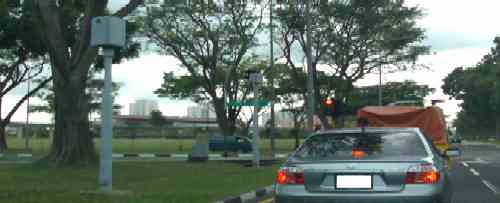
LTA is going to install another 129 J-Eyes to monitor for red light offence at traffic junctions. It is almost double the total number with the 132 J-Eyes already in use. Singapore's land size is 682 square kilometres and thus, there is a J-Eye within an average area of 2.6 square kilometres. If you drive about 15 kilometres to work daily, you may drive through an average of SIX junctions with J-Eyes .... think about that.
LTA is also looking for camera technology to catch offenders for bus lanes, illegal parking, stopping and even modification to vehicles. And I am thinking that camera phone is the norm ... if LTA offers a small fees for all residents to submit proof of offence via MMS, LTA will be swarmed since most motorists will violate the many rules that are in existence.
I also notice that there are cameras mounted on lamp posts along the expressway. I think they facilitate the monitoring of the traffic condition and you can even view the traffic cameras at the OneMotoring website http://www.onemotoring.com.sg/publish/onemotoring/en/on_the_roads/traffic_cameras0.html. Well, it should be easy to put in a software that compares the time and location of a passing car among the cameras to determine if one exceeds the speed limit.
With all these eyes around Singapore, my driving habit is adjusted to be mostly compliant ... only exceeding speed limits by less than 10km/h. I find that if I give myself enough time to get to my destination, I have a more relaxed drive and do not have tendency to rush past a changing light. Try that ... afterall, most of us possess a phone that has functions to fill our time if we get to our destination ahead of the appointment time. Drive safely especially when you are being watched all the time!

2 comments:
Hi I'm doing a project on this Jeyes thing and just wondering, what does the J-eyes do?
J-eyes, I believe J stands for Junction. So, these cameras are set up at road junctions linked to the sensors across the road surface. If a vehicle crosses after the traffic light turned red, the sensor will trigger the camera to snap a picture of the vehicle running the red light. Once the local authority retrieves the image, a summon will then be sent to the registered owner of the vehicle.
Post a Comment